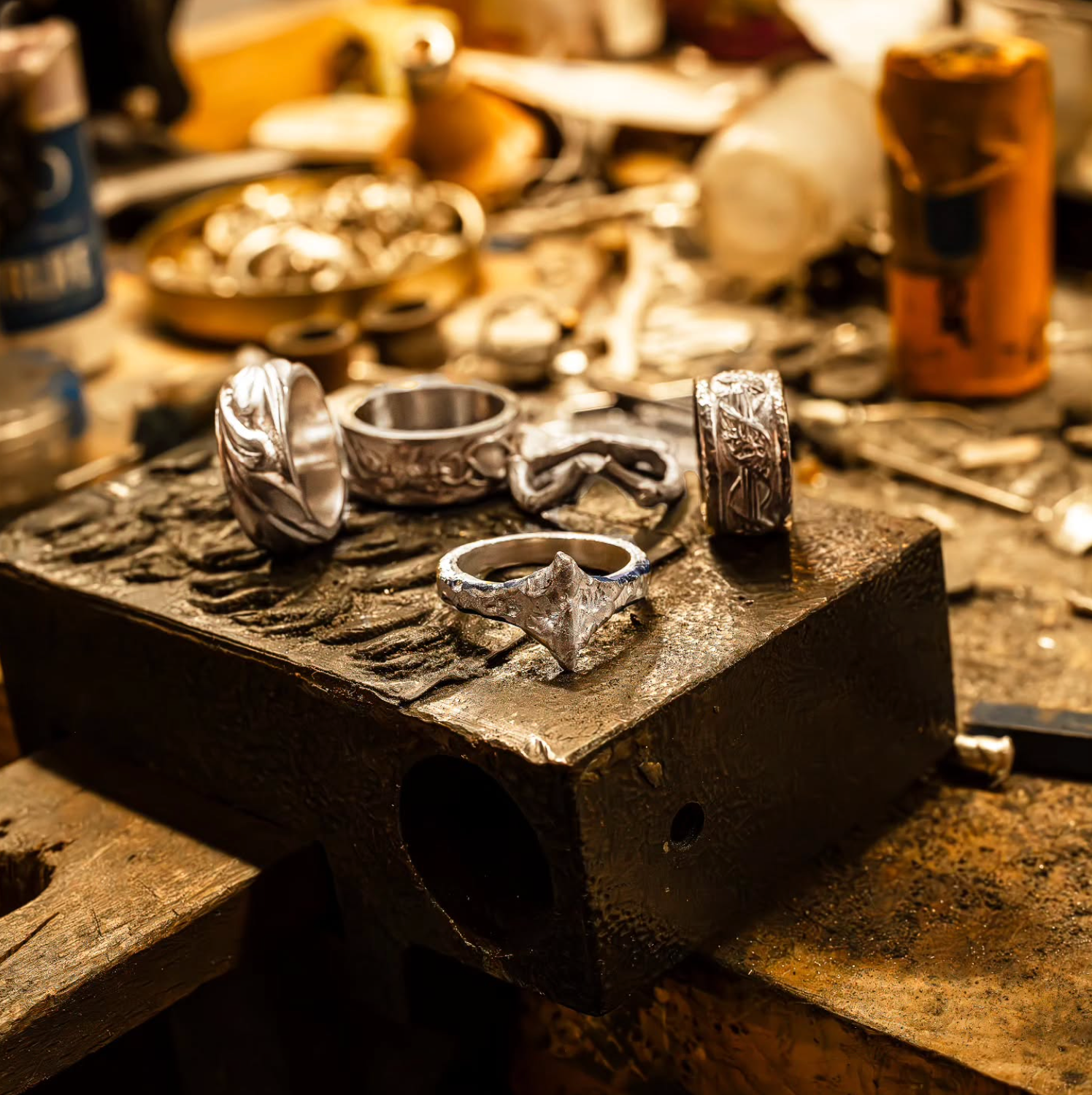Introduction
Have you ever fallen in love with a piece of jewelry, only to have it break, have a stone fall out, need to be replated, or turn your skin green within weeks? Or maybe you’ve searched high and low for something that truly reflects your unique style, only to find store after store selling the same uninspired designs. It’s frustrating when the jewelry world seems to cater only to mainstream trends, leaving those with a love for history, fantasy, and craftsmanship feeling overlooked.
Here’s the thing: It’s not just you. With so many options available online and at events like Renaissance fairs and conventions, it can be difficult to tell what’s genuinely high-quality and what’s just a clever marketing tactic. The last thing you want is to invest in a piece that looks beautiful at first but falls apart too soon.
But imagine this instead: Owning a piece that feels like a personal treasure. Something handcrafted, unique, and made to last. A ring or pendant that carries a story, built with the kind of artistry that can be passed down for generations.
So, what’s the real difference between handmade and mass-produced jewelry? Let’s break it down.

The Historical Significance of Jewelry-Making
Jewelry has been a symbol of status, protection, and personal expression for thousands of years. From ancient Egyptian goldsmiths crafting intricate amulets to medieval artisans shaping fine metalwork, jewelry-making has always been an art rooted in culture and tradition.
Even today, many traditional techniques remain essential in handmade jewelry, keeping the legacy of craftsmanship alive.
Ancient Techniques Still Used Today:
- Lost-Wax Casting: A method dating back over 6,000 years, this technique involves sculpting a design in wax, creating a mold, and casting it in metal. It’s still widely used in artisanal jewelry, including my own designs.
- Hand Engraving: Before modern machines, jewelers used fine chisels and gravers to carve intricate patterns into metal by hand—a practice I continue to use for custom detailing.
- Forging and Hammering: Traditional blacksmithing techniques involve hand-hammering metal into shape, adding strength and character to each piece.
- Granulation & Filigree Work: These delicate methods of fusing fine metal details into jewelry were popular in ancient Greek and Etruscan pieces and are still seen in intricate handmade designs today. Granulation is a technique I frequently turn to when creating textured pieces.
Mass production has largely abandoned these detailed techniques in favor of machine-cutting or computer-aided design and mass assembly. But handmade jewelry keeps history alive by honoring these traditional methods, blending timeless artistry with modern creativity.
Craftsmanship & Quality: The Heart of Handmade Jewelry
One of the biggest differences between handmade and mass-produced jewelry is the level of craftsmanship that goes into each piece. The difference in quality is distinctly noticeable. Here’s what you can expect from handmade versus mass-produced jewelry.
Handmade Jewelry:
- Every piece is crafted with care, precision, and artistry.
- Artisans personally shape, polish, and assemble their creations, ensuring no detail is overlooked.
- Quality control is personal, meaning flaws are caught and corrected before a piece reaches you.
- Many handmade jewelers, like myself, include a maker’s mark or signature, adding authenticity and a personal touch.
- Unlike mass-produced jewelry designed for cost efficiency, I never cut corners. My rings, for example, are curved on the inside for a more comfortable fit—a small detail that makes a big difference in wearability.
Before shipping, I personally inspect each piece for polish, symmetry (or asymmetry when it’s called for in organic pieces), and structural integrity. If anything isn’t perfect, I adjust it by hand or remake it if necessary- to ensure you receive a flawless piece.
Mass-Produced Jewelry:
- Often produced in high-volume factories, emphasizing speed over true craftsmanship.
- Equipment frequently handles most of the work, making these items more machine-made than created by actual humans.
- They are often plated, which requires costly replating once the coating wears off or necessitates discarding the piece when it discolors.
- Additionally, many of these items are designed with hollow areas or generally thinner materials, prioritizing cost over quality, which can diminish their lifespan.
- Many are made from metals that cannot be resized or repaired by a jeweler, such as steel, titanium, zinc, or tungsten, forcing you to throw them away or purchase a completely new piece when they break or no longer fit.
- Machine-cut and assembled components can sometimes lead to weaker settings, while cheaper pieces might have stones glued in place instead of being properly set.
- Quality control is frequently inconsistent, resulting in noticeable defects.
When you choose handmade, you’re choosing a piece made with intention—one that will last and feel special every time you wear it.
Materials Matter: What’s Inside Your Jewelry?
The materials used in jewelry play a huge role in durability, beauty, and long-term wearability. Handmade jewelry is made to be worn and enjoyed for years while maintaining its beauty.
Handmade Jewelry:
- Typically uses high-quality metals like solid gold, sterling silver, platinum, or responsibly sourced materials.
- Artisans handpick gemstones, ensuring each is well-cut, durable,and responsibly sourced.
- Designed to last a lifetime, with superior finishes that resist tarnishing and wear.
- In my work, I use Argentium® silver—a premium silver alloy known for its exceptional durability, sustainability, and tarnish resistance. Investing in Argentium® silver means you’re choosing a high-quality piece that will last while also making a responsible, sustainable choice.

Spotlight: Skölland’s Raven at Night Wax Seal Pendant
There are two reasons why I chose to use Argentium® silver for the Raven at Night Pendant.
First, its bright white color provides a striking contrast against the patina, making the design details pop.
Second, Argentium® is incredibly easy to maintain. This special silver alloy contains germanium, which, combined with its reduced copper content, makes it highly resistant to tarnish.
Unlike traditional sterling silver, Argentium® requires no rhodium plating to achieve its bright white color. With its increased tarnish resistance, a simple wipe with a polishing cloth is all that’s needed to keep your piece looking brilliant.
Mass-Produced Jewelry:
- Frequently made with low-cost metals that require plating, such as brass, copper, nickel, and zinc (to name a few). These materials are often coated with gold or rhodium, which tends to wear off quickly.
- Often uses synthetic or low-grade gemstones, which can be inconsistent in cut and quality.
- More prone to breaking, discoloration, and weakened settings within months.
A common question I get is, "What metal is right for me?" Many assume gold is the only option, but that’s not always the case. The answer depends on your lifestyle, budget, and personal taste. My goal is to empower you with the knowledge to choose the best material while ensuring that my pieces stand the test of time.
Uniqueness & Personal Connection: No Two Handmade Pieces Are the Same
One of the greatest joys of wearing handmade jewelry is knowing that your piece is truly unique.
Handmade Jewelry:
- Each piece is a true work of art, shaped by the hands of a skilled artisan with your unique style in mind.
- Custom and bespoke options allow you to create something deeply personal and meaningful.
- Prioritizes timeless artistry over fleeting trends.
Mass-Produced Jewelry:
- Made in large batches, meaning thousands of identical pieces exist.
- Rarely offers customization, making it difficult to find something truly personal.
- Often follows trends rather than creating something with lasting appeal.
Many of my clients cherish the fact that their jewelry is one-of-a-kind. Whether it’s an engraving that holds special meaning or a design inspired by medieval or fantasy aesthetics, my goal is to create something that speaks to you.
Ethical & Sustainable Choice: Supporting Real Artists, Not Factories
Beyond aesthetics and durability, choosing handmade jewelry is an ethical decision.
Handmade Jewelry:
- Often uses fair-trade gemstones, recycled metals, and conflict-free materials.
- Many artisans implement sustainable, low-waste practices in their studios.
- Supports independent artists and small businesses rather than mass-production factories.
Mass-Produced Jewelry:
- Often prioritizes profit margins over ethics, sometimes using low-wage labor.
- Often designed for a specific price range, meaning the integrity of pieces can suffer when profit margins are prioritized.
- Unregulated supply chains may lead to unethical sourcing practices.
- Generates more waste and environmental harm through excess production.
By choosing handmade, you’re not just buying jewelry; you’re investing in ethical craftsmanship and supporting artists who genuinely care about the integrity of their work.
So, Why Does Handmade Cost More?
You might be wondering, Why is there such a big price difference between handmade and mass-produced jewelry…
I price all of my pieces intentionally based on time, difficulty, technique, and materials used. When you buy from me, you’re not just paying for a piece of jewelry—you’re investing in craftsmanship, longevity, and personalized service. Plus, I stand behind my work with free inspections, cleanings, and minor fixes to ensure your piece remains as beautiful as the day you bought it.
Ready to Find Your Next Prized Piece?
If you’re tired of settling for mass-produced jewelry that doesn’t last, I invite you to explore my collection of handcrafted, high-quality pieces. Each design is made with care, using the finest materials, and crafted to last a lifetime.




